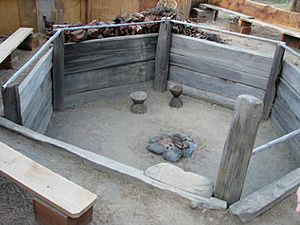Tsnungwe facts for kids
| tse:ning-xwe | |
|---|---|

łe:lding xontah - mouth of the South Fork of the Trinity River, principal Tsnungwe village
|
|
| Total population | |
| 150-200 | |
| Regions with significant populations | |
| California (Salyer ) | |
| Languages | |
| Hupa, Chimariko |
The Tsnungwe (pronounced Tuh-SNUNG-wee) are a Native American people. They have lived for a very long time in what is now California. Their homeland is around the Trinity River and its South Fork. This area includes places like Willow Creek, Salyer, and Burnt Ranch.
The Tsnungwe people speak a special language. It is a dialect of the Hupa language. They also used to speak Chimariko. The Hupa people call them tse:ning-xwe, which means "Tse:ning-din (Ironside Mountain) People."
The Tsnungwe have two main groups. One group is called łe:lxwe, meaning "People of łe:l-ding." This was their most important village and religious center. The other group is called Chima:lxwe or Tł'oh-mitah-xwe. This means "grass, prairies-amongst-people" and they lived along the New River.
Sometimes, the Tsnungwe are called "South Fork Hupa." This is because their language is a dialect of Hupa. Other names for them include "South Fork Indians" or "Burnt Ranch Tribe."
The Tsnungwe lived near many other tribes. These included the Yurok, Karuk, and Wintu. It was common for Tsnungwe people to speak several Native languages. One famous Tsnungwe leader, Saxey Kidd, was known for speaking many languages.
The Tsnungwe are a peaceful people. Their lives are centered on family, traditions, and their land. The land has always provided them with food. They hunted deer and caught salmon and steelhead fish. They also gathered many local plants. Even with new settlers coming to their land, they have kept their strong family groups. They continue to practice their old traditions and values.
Today, the Tsnungwe descendants are part of the Tsnungwe Council. This council is recognized by Humboldt and Trinity counties. They are working to get their status as a federally recognized tribe restored by the United States government.
Language of the Tsnungwe
The Tsnungwe language is a special form of the Hupa language. The Hupa language belongs to a larger group called Pacific Coast Athabaskan languages. These are Native American languages spoken along the Pacific Coast.
The Hupa language has different dialects, or ways of speaking. The Tsnungwe speak the dialect of the South Fork and New River areas. Other Hupa dialects include the Hoopa Valley Hupa and the Redwood Creek Hupa.
Tsnungwe Villages
The Tsnungwe people lived in many villages. These villages were spread out along the Trinity River and its South Fork. Their main village was called łe:l-ding. This important village was located where the South Fork and Trinity rivers meet. It was a very old village, and in ancient times, it was a special place for ceremonies.
The Tsnungwe had villages in different areas:
- Willow Creek Area: Many villages were located around Willow Creek. These villages had names like misqine:q'it and xoxo:ch'e:lding.
- South Fork Trinity Area:' This area was called yisinch'ing-qeh. Besides łe:l-ding, other villages here included chway-me (Sandy Bar) and dilchwehch-ding. The latter was once a very important and wealthy settlement.
- Trinity River (South Fork – Cedar Flat Area):' Villages in this part of the Trinity River included miy-me and kin-sa'an-ting.
- Burnt Ranch and New River Area: A large settlement was at tse:n-ding, which is now Burnt Ranch. Other villages were found along the New River, such as yiduq-nilin. The Hupa speakers in the New River villages were known as tł'oh-mitah-xwe.

